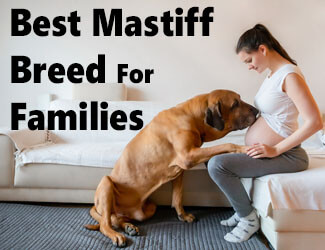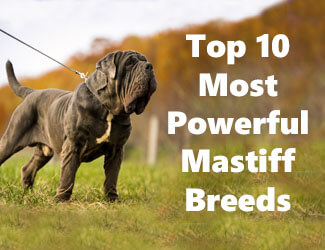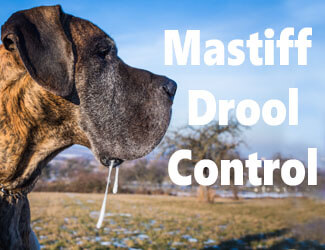What To Know About Mastiffs
Your 43 Top Questions Answered
by Ken Alden
What to know about Mastiffs? Wow, where do we begin?
They’re such unique dogs that we’ve dedicated this page to answering dozens of the most frequently asked questions about them, but in short....
Here's What To Know About Mastiffs...
Mastiffs are loyal dogs who love people. They don't do well as backyard dogs because they need companionship and aren't equipped to withstand extreme outdoor conditions. They're slobbery, and some of them snore, but people who can overlook those things find that mastiffs make lifelong friends.
This article will answer 43 of the most commonly asked questions about mastiffs, from shedding and howling habits to their lifespans and feelings about water. If you’ve ever had a mastiff-related question, you’ve come to the right place….so let’s get to answering your questions! Start Below...
Pro-tip: Ever try lifting a Mastiff? Their weight can hurt not only your back but their joints when they hop down from cars, sofas or even your bed. To protect your back and theirs check out the best Mastiff ramps on Amazon.com now.

Do All Mastiffs Drool?
While all mastiffs drool, some drool more than others.
The slobber is most evident when they are eating, drinking, or sleeping, but any mastiff owner will attest that slobber rags are a must when dealing with mastiffs. HugeHounds (thru Amazon.com) makes the best ones.
When it comes to what to know about mastiffs drooling is important to consider before bringing one home then discover this when it starts shaking it's head.
Why Do Mastiffs Drool?
Any of the following could cause a mastiff to drool:
- Anticipating or smelling food
- Being too hot
- Anxiety or nervousness
- Excitement
- Dental problems
- Motion sickness
- Prolonged chewing
- Dehydration
- Underlying illness
Because of their loose lips, they’re less able to control their drool than other dog breeds, so just about anything can cause them to drool.

So, do all mastiffs drool? Which ones drool more than others? Learn everything you ever wanted to know about mastiff drooling.
Do All Mastiffs Shed?
Mastiffs shed heavily once or twice a year and need daily brushing during those periods. Throughout the rest of the year, shedding is average to moderate and necessitates weekly brushings. Although they shed moderately, keep in mind they have more body size to shed from, so shedding might seem like a lot.
Pro-tip: Mastiff anxiety, aggression, destructive chewing, jumping up, fearfulness, and other behaviors can be controlled with the right training program.
Here’s a great course that
addresses these issues along with many other dog training basics: Check it out now!
Do Mastiffs Attack?
Any dog will attack under extreme circumstances, but there’s a reason mastiffs are called “gentle giants.” They don’t usually attack, even when provoked and prefer to avoid conflict. They’ll defend themselves if attacked, but it’s rare for mastiffs to attack anything first, and it’s almost unheard of for them to attack unprovoked. Regardless of breed, learning proper socialization is always advised.
Do Mastiffs Bark a Lot?
As a general rule, mastiffs bark less than most other dog breeds, as they’re generally quiet, calm dogs. They’re good watchdogs, though, and will bark to alert their owners of anything out of the ordinary. what to know about mastiffs
Do Mastiffs Drink a Lot of Water?
Mastiffs drink a ton of water, especially when it’s hot. Most dogs drink about one ounce of water per pound of body weight (29.7 ml per 0.45 kg) each day, but mastiffs often drink more. It’s not uncommon for them to drink one to two gallons (3.79 to 7.57 liters) a day in the summer. Much of which they seem to lose in the form of drool. lol
Do Mastiffs Get Cold?
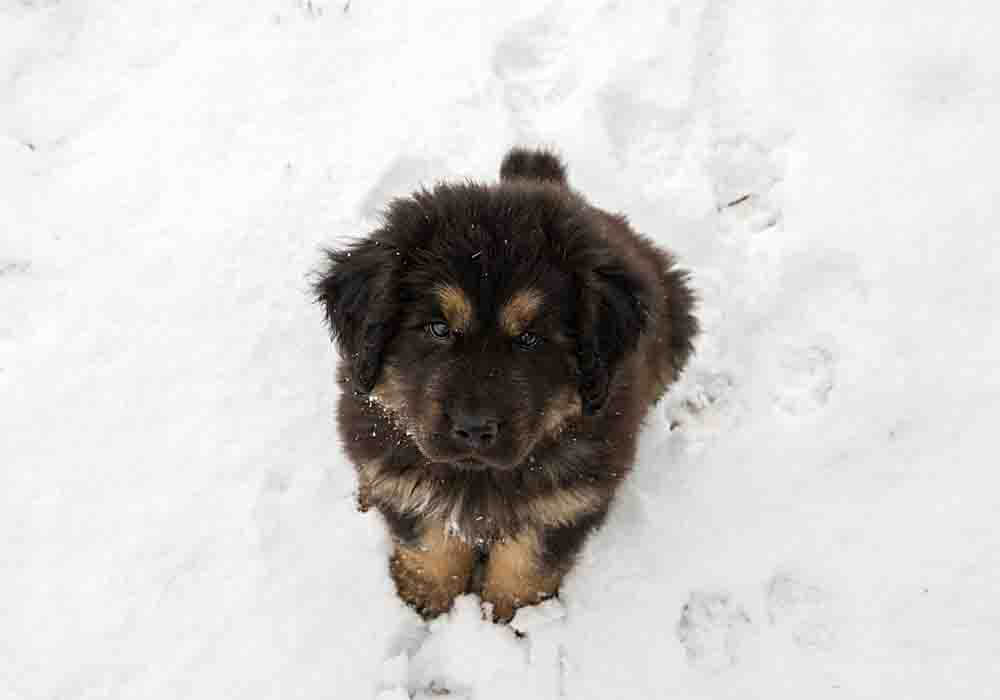
When it comes to what to know about mastiffs this is very important...
Because of their size and ample coats, mastiffs handle cold weather fine. However, they can't deal with extremely frigid temperatures but prefer cold weather to hot and humid weather. This doesn’t mean they’re “outside” dogs though. Here’s a great page about this topic on this site.
Do Mastiffs Get Fleas?
Mastiffs are just as susceptible to fleas and ticks as any other dog. The best defense against them is a monthly flea and tick pill. Be sure to read our helpful in depth article on prevention.
Pro-tip: Mastiff's (and their owners) love dog crates…and for good reasons. Crates keep dogs from mischief while you're away, are perfect for house training, for traveling by car, and provide the dog a place to de-stress. Check out the best Mastiff crates on Amazon.com now.
Do Mastiffs Get Lonely?
Mastiffs have calm, friendly dispositions, but they’re also sensitive and need ample time with their humans or other dogs. If mastiffs are left alone for too long, they become anxious and lonely. If this happens too often, it can change their personalities and also make them destructive.
Do Mastiffs Have an Undercoat?
Mastiffs are double-layered, with short and dense undercoats, which is why they shed all year long. Like all double-coated dogs, mastiffs need grooming year-round, so owners should get them used to the grooming process while they’re still puppies to avoid future problems. what to know about mastiffs
Do Mastiffs Have Breathing Problems?
Some dogs of every breed are born with peculiar health problems, but usually, mastiffs don’t suffer from breathing problems. Although occasionally, mastiffs with heart disease can experience trouble breathing, especially in the late stages of their lives. Read more about the health issues that Mastiffs do suffer from in our article here.
Do Mastiffs Have Rear Dewclaws?
Many mastiffs have rear dewclaws, and some even have double rear dewclaws, which aid with stability.
Do Mastiffs Have Sensitive Stomachs?
It’s common for a mastiff to suffer from food allergies, sensitive stomachs, upset stomachs, and other tummy troubles. They are also at higher risk for bloat than many other dog breeds. Because they’re so large, their weight puts a lot of strain on their bones and joints, so they’re not one of the most active breeds, meaning they’re prone to obesity.
When it comes to what to know about mastiffs, their weight is not only important to watch but to keep in check before it gets out of control.
All that said, it’s crucial that mastiff owners find the right food and exercise routine for their dogs to keep them healthy. Sometimes, the only way to do this is with a visit to a vet, who can run allergy tests on the dogs that get to the root of the stomach problems.
Once owners know what’s causing the issues, they can correct them. Sometimes it’s a simple fix, such as avoiding certain types of protein.
Do Mastiffs Have Webbed Feet?
Some bullmastiffs have webbed feet, although the webbing is much smaller than that of other webbed-feet dogs. Other mastiffs aren’t known for having webbed feet.
Do Mastiffs Howl?
Mastiffs are generally quiet dogs who only bark if their watchdog nature kicks in and pushes them to alert their owners of something unusual. They’ll howl on occasion, usually if they hear a siren in the distance or other dogs howling outside.
Occasionally, very sick or old mastiffs will howl if they’re in extreme pain or distress, but this is unusual. They mostly tend to suffer in silence.
Do Mastiffs Like Other Dogs?
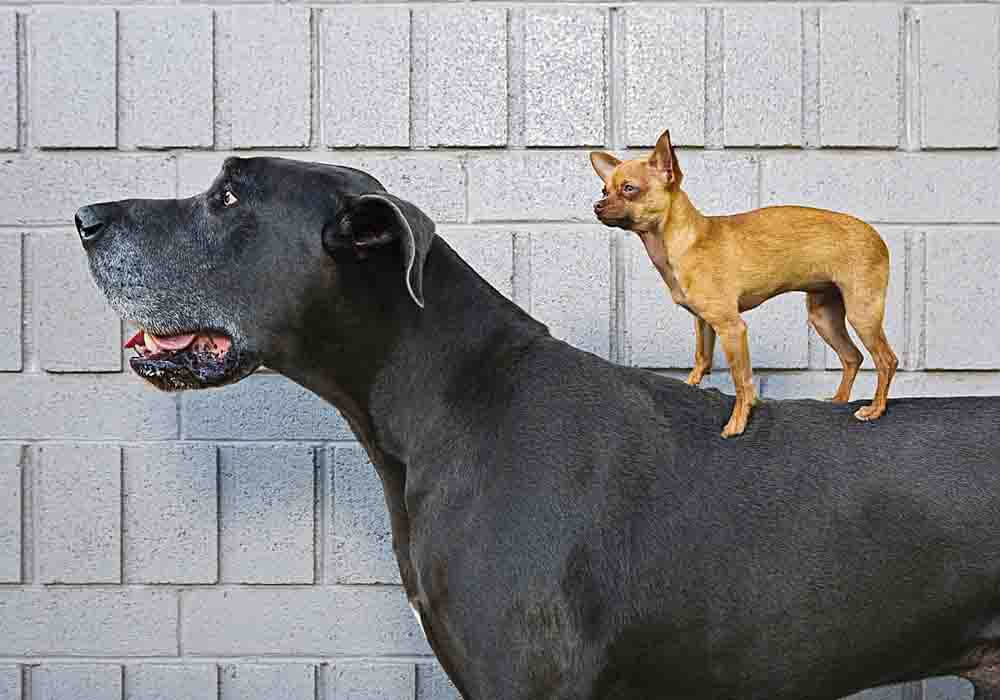
Mastiffs love people and other dogs, making them highly social. Despite their large size, they even get along well with cats. Mastiff owners who are often away from home remedy the loneliness problem by getting another dog. As long as mastiffs have some form of company, they’re fine.
Do Mastiffs Like Snow?
English mastiffs, Bullmastiffs, and Neapolitan mastiffs don’t care for the snow and prefer mild weather. However, Tibetan mastiffs do fine in the snow, as they were initially bred in the Himalayas and are used to cold weather. Even so, people shouldn’t leave them outside in extreme temperatures for extended periods.
Do Mastiffs Like To Cuddle?
Mastiffs love to cuddle. They’re like giant, warm, slobbery cuddle machines. Furthermore, snuggling a mastiff isn’t only good for him; it’s also beneficial for his owners. Science has shown that cuddling with dogs provides humans with several advantages, such as a lowered risk for strokes, decreased stress levels, and less depression.
Being cuddled also provides benefits to the dogs. They feel loved and secure as it increases their trust in and bond with their owners, and helps ease anxiety. The only downside to cuddling with mastiffs is that they want to cuddle all the time. Once an owner starts snuggling, it might be hard to stop.
Once they become full-grown, mastiffs still crawl in laps and think they should sleep in the same bed as their humans. This Lina the Mastiff YouTube video perfectly portrays mastiffs’ affinity for cuddling:
Do Mastiffs Like To Run?
Mastiffs need about the same amount of exercise as humans, but like many humans, many mastiffs don’t want to exercise. They’re relatively sedentary dogs when fully grown and aren’t passionate about running and playing like labs or collies.
Bullmastiffs are the exception. They remain fairly active even when fully grown, and enjoy a good run.

Considering their large size, just how fast can mastiffs run?
You might be surprised to find out just how fast they can go.
Do Mastiffs Like To Swim?
Although owners can teach mastiffs to swim with a good amount of training, they’re not predisposed to enjoy it. They prefer curling up in a big bed with their favorite people.
Again, bullmastiffs are the exception. Some of them are fond of swimming, and they take to the water pretty naturally, thanks in part to their slightly webbed feet.
Do Mastiffs Like Water?
Mastiffs love to drink water, and some of them consume a gallon or more a day. Other than that, they’re not huge fans of it. Some mastiffs learn to love it if trained properly, but for the most part they prefer dry to wet.
Do Mastiffs Make Good Family Dogs?
Mastiffs make excellent family dogs. They bond well with multiple humans, and they have sweet, gentle dispositions that make them perfect for children and the elderly. The chance of mastiffs attacking or biting is almost non-existent, so they aren’t likely to snap at toddlers who accidentally step on their tails.
Although mastiffs are excellent family dogs, owners should supervise them when they’re playing with children. While their sheer size doesn’t make them dangerous, it occasionally leads to accidents, such as knocking toddlers over or sitting on them.
The same is true with the elderly. Mastiffs are great companion dogs for seniors because they’re so gentle and calm. However, an affectionate leg bump could easily knock a fragile person to the ground.
Furthermore, as we’ve already established, mastiffs are cuddly. A 200-pound (90.72-kg) mastiff crawling into the lap of a man in his prime is no trouble, but a 200-pound mastiff crawling into the lap of a toddler or a 90-year-old woman is a different story.
Do Mastiffs Make Good Pets?
Mastiffs make good pets to people with the appropriate resources. They’re mostly quiet, well-mannered dogs who are patient and loyal to a fault. That said, however, mastiffs are expensive pets, as they require a lot of food, occasional professional grooming, and regular vet visits.
They’re also more likely than some other dogs to suffer from heart disease, cancer, elbow and knee dysplasia, obesity, and a few other illnesses, which are expensive to treat.
They’re better as house dogs than outside dogs, and need plenty of living space. Mastiffs may not be the best pets for people on limited budgets or those who live in small, studio-type apartments.
Do Mastiffs Make Good Service Dogs?
The same traits that make mastiffs amazing pets also make them excellent service dogs, as their size is great for people with mobility issues. Their loyalty, sweet dispositions, and tendency to bond make them great for people with other emotional or psychiatric problems, such as PTSD, depression, and anxiety.
Do Mastiffs Need a Lot of Space?
Yes! Mastiffs need plenty of space, and their owners need enough room to navigate around them. People with limited living spaces shouldn’t own mastiffs.
Here’s a great article of ours that addresses Mastiffs living in apartments and all that needs to be considered.
Do Mastiffs Need Winter Coats?
Mastiffs are double-layered, so they have nice, thick coats. Even so, they’re not well-suited to lots of ice and snow. Pet owners who live in cold, snowy places should invest in appropriate winter clothes for their mastiffs.
They’ll need shoes to protect their feet from the icy ground and warm winter shirts or coats. BESUNTEK Warm Winter Big Pet Dog Boots are skidproof and anti-slip and cover a large surface area on dogs’ legs to keep them warmer. The Dociote Store Reflective Winter Coat comes in sizes as large as 6XL, making them a go-to for many mastiff parents.
Do Mastiffs Sleep a Lot?

Mastiffs sleep between 16 and 18 hours a day, while mastiff puppies sleep up to 20 hours a day. They’re easily one of the laziest dog breeds, but their extended sleeping hours make them a good companion choice for the elderly, who may not have the energy for more active, playful dogs. This helpful page of ours discusses the Mastiffs sleeping habits in greater depth.
Do Mastiffs Smell Bad?
Mastiffs have short, quick-drying coats, so with regular bathing every six weeks or so, they shouldn’t smell bad. If mastiffs stink even after bathing, it might be due to an underlying medical condition such as fungus between the toes or impacted anal glands. Owners should take stinky mastiffs to the vet to determine the underlying problem.
How Long Do Mastiffs Grow?
Mastiffs' muscles, bones, and joints should be fully developed by the time they're two years old. However, they may continue to grow until they're about three years old, which is also when they tend to lose their puppy-like nature.
How Long Do Mastiffs Live?
Mastiffs, like other large breeds, have shorter lifespans than many other breeds and usually live about nine or ten years.

Every mastiff breed grows and lives to a different size and age. This article of ours, How Long Do Mastiffs Grow And Live gives specific answers for each breed...where is yours on this list?
Why Do Mastiffs Die Young?
It wasn't clear why large dog breeds died sooner than smaller, more commonly-sized breeds for a long time. However, according to research conducted over the last few years, scientists have determined that it is because large dog breeds tend age at an accelerated rate.
In other words, a year for a large dog is equivalent to a year and a half to two years for a smaller dog. Big dogs age quicker, so they reach "old age" sooner than smaller dogs.
What Do Mastiffs Die From?
Three main issues cause death in mastiffs:
- Cancer
- Bloat (Gastric Dilatation-Volvulus)
- Canine Heart Disease
Other frequent health problems include epilepsy, eye problems, obesity, and joint problems. Many mastiffs also die from old age.
When Do Mastiffs Calm Down?
Mastiffs are reasonably calm dogs. However, they retain much of their puppy-like ways until they're about three years old. After three years, they rarely exhibit any hyperactivity or destructive habits like chewing or shredding.
How Much Do Mastiffs Eat?
Most mastiffs eat between six and ten cups of dry dog food per day. Most owners also provide liberal snacks for their furry friends. Considering how much they eat, this leads to the question of how much does it cost to feed them? Which we answer here...
When it comes to what to know about mastiffs knowing this is important before you bring one home and are surprised that your dogs food bill is higher than you thought.
How Much Do Mastiffs Weigh?
Fully grown male mastiffs usually weigh between 160 and 230 pounds (73 and 100 kg). Fully grown female mastiffs generally stay between 120 and 170 pounds (54 and 77 kg).
However, some mastiffs have grown larger than average, with the largest one weighing in at 343 pounds (155.6 kg). His name was Zorba, and this YouTube video talks all about him:
How Often Do Mastiffs Go in Heat?
A mastiff’s heat cycle occurs once every eight months. Our article here will answer all questions you have about their heat cycle.
How Old Do Mastiffs Live?
Mastiffs don't usually live past ten years, although some have lived longer. The longest-lived mastiff was a female named Kush who was 15 years old but that is rare.
Where Do Mastiffs Come From?
People once used the term 'mastiff' to describe any large dog, which is why there are so many "mastiffs" that aren't true mastiffs. English mastiffs, however, are originally from England, where people bred them as fighting and guard dogs over 2,000 years ago.

Over thousands of years mastiffs played more of a utilitarian role in society rather than that of beloved pet. But what was that role? Our fascinating article What Were Mastiffs Bred For answers this.
Why Do Mastiffs Have Red Eyes?
Mastiffs’ eyes get red much more often than other dogs because they frequently suffer from eye allergies. They are also more likely to develop other eye problems, such as entropion, cataracts, or progressive retinal atrophy. They also go blind at higher rates than most other dog breeds.
Why Do Mastiffs Lean on You?
These are the most common reasons a mastiff may lean against his favorite person:
- He’s anxious, and feeling his human against him is comforting.
- He’s showing his owner affection, letting him know that he loves him.
- He might be trying to get his human to go a certain way or do something like head into the kitchen to feed him.
Why Do Mastiffs Nibble?
Also known as “mouthing,” this behavior is a throwback to when the dog was still a puppy living with his mom and other littermates. It’s how they played and showed affection to one another. what to know about mastiffs
If a pup is nibbling on someone, he trusts that person and feels playful.
Why Do Mastiffs Paw At You?
Pawing is a sign of affection, which can mean the dog wants attention or needs something. Mastiffs are intelligent dogs. If they need to use the bathroom or are hungry, they have ways of letting their human know, such as pawing.
Pawing could also happen if the dog smells something interesting on someone’s clothes. He could simply be digging for the scent to try to find the source.
Why Do Mastiffs Sit On You?
Mastiffs may be huge, but that doesn’t mean they know they’re huge. They love to cuddle and sit on laps and be close to the people they love. It’s the same principle behind a dogpile. When a bunch of puppies love and trust each other, they often sleep sprawled all over one another. When a mastiff loves someone, he does the same thing.
What To Know About Mastiffs...Final Thoughts
Mastiffs are excellent pets with sweet, calm, and gentle dispositions. They’re intelligent, patient, and a little lazy, making them perfect as house dogs, service dogs, family dogs, and dogs for the elderly. Even so, they eat a lot and require regular grooming and vet visits.
They also need lots of space, so potential mastiff owners should have plenty of room in their homes and enough money to keep up with this dog’s needs.
Return to the top of this What To Know About Mastiffs page

About the Author...
Ken Alden, a dedicated Mastiff owner for over eight years, is acclaimed for his expertise in care, grooming, and training. Read more About Me and my dog Shadow.
- Mastiff Guide Home ›
- Mastiff Dog Info ›
- What To Know About Mastiffs

